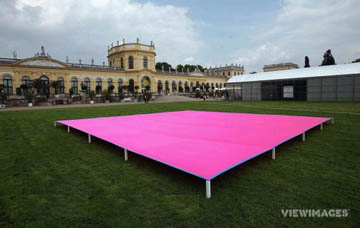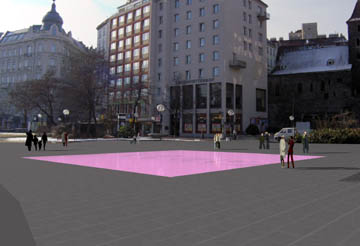In 1968, Atsuko Tanaka created a large pink square of fabric floating over the grass. This summer the pink plane was re-created at Documenta 12 in Kassel.
In Austria, another square pink will be constructed as a shallow pool in 2007. The “Der Rosa Platz” by Hans Kupelwieser is the Monument for Homosexual and Transgender Victims of the Nazi Regime in Austria. The letter “QUE(E)R” will rise from the pool as stepping stones. The Art in Public Places of Vienna website states that the work refers to the pink triangle used by the Nazi’s to designate homosexuals. The pink water will reflect the surrounding buildings in a pink tone.
One pink square is without defined meaning. One pink square labels itself. One fabric. One water. Both pure color, but one flat and the other reflecting. One demands the joy the seeing color. One uses color to celebrate freedom from the past.
Which is better public art? And to whom?

Atsuko Tanaka

Hans Kupelwieser
Sign up for the Monthly email that lists the Aesthetic Grounds essays and links.
Public Art, Public Space

Better?
Dont you mean Gooder?
I have been arguing this Good/Bad thing lately with a bunch of ironclad conservatives who insist Rembrandt is the benchmark by which all else shall be judged.
I insist Better is a subjective term, especially when it comes to Pink Squares, or even Legendary Pink Dots.
And when you throw the term “Public Art” into the mix, especially when it is as variably defined as it seems to be these days, your question becomes even impossibler to answer.
Isnt your question related to your answer to Blake Gopnik?
That is, shouldnt we be applying the Rodney King paradigm here, and all get along?
Each one of these pink squares is unequally interesting in different ways, because the individual artists each have their own entire lifetime of baggage, emotional, intellectual, historical and cultural, that they bring to the pink square.
The world has room for both, and plenty more to boot.
And yes, I like both chocolate AND vanilla.
Reis.
Reply from Weiss
I agree with you 100%. I am just starting to explore the number “1” taboo of art culture: Obvious Similarity between Artworks. It is only discussed in whispers. Every artist hates it.
Ophan Pamuk discussion of Islamic miniatures has a method to get through this problem of similarity without insulting the artists of common exploration or accidental repetition. Do you think the Nobel laureate would spend a few hours helping me figure it out?
In terms of gooder. The phrase “for whom” must always be applied. Gooder by itself is fairly self centered.
Glenn
As they say, if white is the new black, and pink is the new white, then pink is, in fact, the new black.